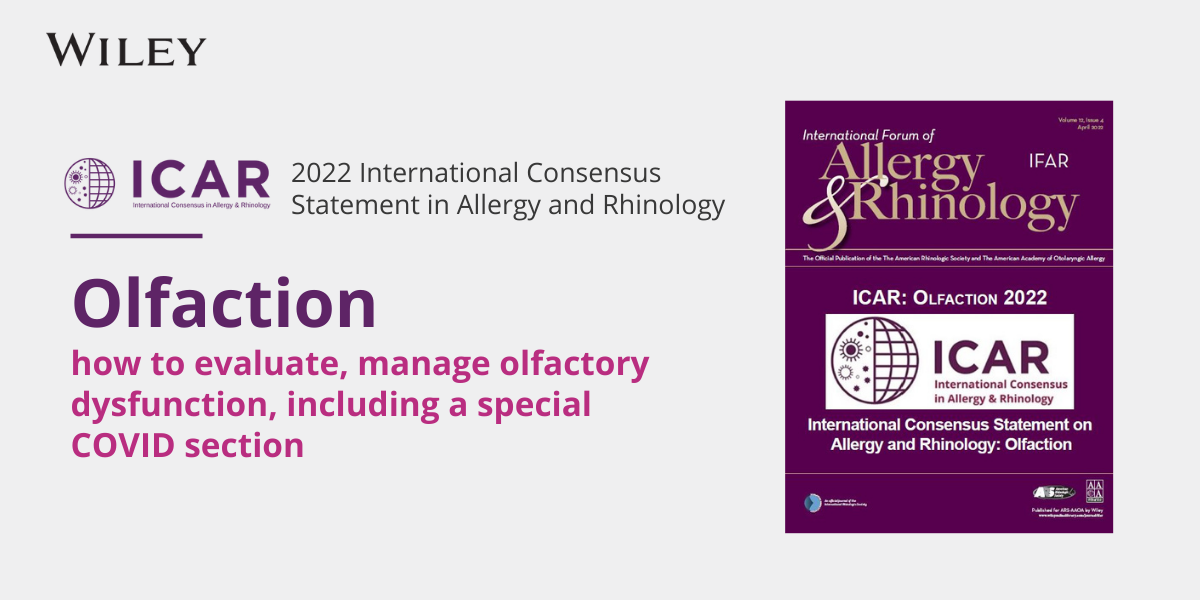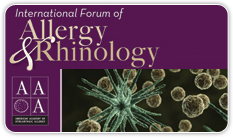
AAOA Annual Meeting On-Demand Pre-Work
Research Forum Abstracts
The Effect of Radiofrequency Ablation of Posterior Nasal Nerves on Inflammatory Cytokines, Peak Nasal Inspiratory Flow, and Subjective Symptoms Scores In Chronic Rhinitis: A Prospective Clinical Trial
Allergic rhinitis (AR) is mediated by an IgE-related response while non-allergic rhinitis’s (NAR) pathophysiology is linked to multiple triggers. The presentations of both are similar (both lead to symptoms of congestion and rhinorrhea, the hallmark symptoms of chronic rhinitis (CR)), and treatment consists of intranasal medications which often fail, necessitating further treatment. Radiofrequency neurolysis (RFN) of the posterior nasal nerve (PNN), a terminal branch of the vidian nerve, is utilized to reduce hypersecretion. The NEUROMARK® system from Neurent Medical (Neurent, Ireland) is approved for treatment of CR; this device delivers low level radiofrequency energy to tissues while limiting the total energy delivery via an impedance feedback loop. The efficacy of treatment is currently limited to subjective outcomes. Ideally, objective measurements such as peak nasal inspiratory flow (PNIF) or cytokines to serve as biomarkers for responders or correlate with symptomatic response are identified. PNIF is a measure of airflow through the nasal cavities and is correlated with rhinitis. Type 2 cytokines are linked to AR and have not been explored after PNN treatment. The aim of this investigation was to evaluate symptoms, PNIF, and cytokine changes after RFN of the PNN.
This prospective, single-arm study was conducted at the Texas Sinus Institute at The University of Texas Health Science Center at Houston. Patients with =6 months of CR symptoms, a reflective total nasal symptom score (rTNSS) =6, and refractory to medical management were included. Follow-ups occurred at 4 and 12 weeks, with the primary endpoint at 12 weeks. Symptoms, peak nasal inspiratory flow (PNIF) and cytokines were assessed.
Seventeen patients were enrolled with 15 patients undergoing treatment. The procedure was well tolerated with no major adverse events. The median rTNSS score improved from 7.5 to 4.0 and the median NOSE scores improved from 52.5 to 17.5 at 12 weeks (both p < 0.05). A minimal clinically important difference (MCID) was observed in 67% patients with the rTNSS and 50% of patients with the NOSE score. There were no significant changes in PNIF or cytokines after treatment.
RFN of the PNN is a safe, effective in-office treatment for CR, providing relief for patients refractory to medicine. While symptom scores improved, nasal airflow and cytokine level changes were not consistent indicators of symptomatic improvement.
Monitoring Inflammatory Response to Intranasal Steroids Using a Novel Non-Invasive Sampling Method
Over-the-counter nasal steroid sprays are commonly self-selected by patients but can have poor compliance due to perceived lack of effect. Research has proven these medications are highly efficacious in symptom reduction using quality of life questionnaires. However, studies evaluating immunological marker changes utilize one endpoint, typically 4-12 weeks after treatment. We previously described a novel, non-invasive sampling method of nasal mucosa using Leukosorb strips, allowing reliable quantification of sinonasal inflammatory cytokines at multiple nasal cavity sites. This method enables quicker and more frequent sample collection than brushes, lavages, and biopsies. This pilot study aimed to provide data on sinonasal inflammatory cytokine concentrations during nasal fluticasone propionate (FP) administration.
At each time point, nasal epithelial lining fluid (NELF) was collected using Leukosorb strips inserted into the nasal cavities for two minutes. After baseline, participants self-administered two sprays of nasal fluticasone propionate (FP) in both nostrils twice daily for eight weeks. We collected data on adverse effects, compliance, and Nasal Obstruction Symptom Evaluation (NOSE) surveys. Time points were day 1, day 3, week 1, week 2, week 4, week 6, and week 8. NELF samples were analyzed using an enzyme-linked immunosorbent assay (ELISA) multiplex kit to quantify cytokine concentrations.
Twenty healthy, non-smoking adults participated in this pilot study. The average age was 29.6 +/- 5.8 years. Baseline NOSE score was 18.75. IL-4, IL-5, IL-12p70, and IL-13 levels decreased significantly from baseline following FP usage on repeated-measures one-way ANOVA testing. IL-4, IL-5, and IL-12p70 levels decreased at most time points in multiple comparison testing. IL-10, IL-17, and IL-22 levels showed no significant change. NOSE scores reduced significantly (p=0.02), with peak reduction at week 6 (-10.5, p = 0.03). Participants showed high compliance with FP administration, with 5/160 time points outside protocol. Nasal dryness and bleeding were the most reported side effects.
This study demonstrates the feasibility of using Leukosorb strips for serial sampling of sinonasal inflammatory cytokines in response to intranasal FP administration. Significant reductions in Th2-associated cytokines were observed by day 1, preceding peak subjective improvement in nasal obstruction at week 6. The disconnect between inflammatory changes and symptom relief highlights the complexity of sinonasal disease response. While our cohort included healthy participants, future studies in allergic rhinitis patients are needed to validate findings and optimize sampling intervals. Our methodology offers a promising approach for monitoring intranasal steroid effects and could inform treatment strategies for chronic sinonasal inflammatory conditions.
Convenient but Consistent? Dissecting Direct-to-Consumer Allergy Testing and SLIT Solutions
Limited access to allergy clinics and potentially high costs may hinder patient access to immunotherapies. In response, direct-to-consumer (DTC) immunotherapy companies have emerged, advertising through social media. Direct-to-consumer (DTC) companies offer sublingual immunotherapy (SLIT) through entirely virtual platforms, featuring at-home allergy testing with finger-prick blood sampling, virtual consultations, and home delivery of the drops. This study aimed to 1) determine the concordance of DTC finger-prick testing with standard serum IgE allergen-specific testing and 2) analyze the protein composition of SLIT drops from DTC companies and an academic allergy practice.
Seven participants who underwent allergen-specific IgE ImmunoCAP testing at an academic center also completed at-home tests from two DTC companies (Company A and B). Concordance between the finger-prick and serum IgE results was analyzed using Cohen’s kappa to evaluate the agreement for dichotomous outcomes (positive-negative). In addition, SLIT drops assembled based on the at-home test results (Company A and B) and IgE serum testing (Company C and academic center) for two participants underwent proteomic analysis using Uniprot’s Allergome database for reference.
The at-home allergy tests cost $200-$250 out of pocket. Company A assessed 39 allergens, and Company B tested 41 allergens; both overlapped with 31 and 29 allergens tested by the clinic, respectively. Company A achieved 90% agreement in reactivity (positive vs. negative) with serum testing (k=0.76, substantial agreement), while Company B achieved 82% (k=0.57, moderate agreement). The agreement dropped to 77% (k=0.44, moderate) when comparing the two DTC companies. Concordance significantly decreased when comparing the grading (Class 0-6) for concordance. In the second arm, when analyzing all eight drops (two participants from Company A-C and the academic center, 274 known allergens were identified. The most allergens detected were drops provided by Company C, but a higher abundance of proteins was measured in Company A. Nearly all allergens reported to be included in the drops. A remarkable number of additional allergens not reported to be compounded in the drops were detected in the analysis of all four SLIT providers.
At-home allergy testing via finger-prick blood shows reasonable but not perfect concordance with serum test results. The variability between DTC companies suggests differences in panels or methods, raising concerns about clinical reliability. In addition, even with the same test results, discordance between the DTC and the academic center in solution compounding was noted. While DTC testing offers convenience, discrepancies highlight the potential need for confirmatory testing in traditional healthcare settings. Given the small sample size, these results should be viewed as preliminary, and larger-scale studies are needed to validate these findings and guide the safe integration of DTC models into allergy care.
An Otolaryngology Clinic-Based Penicillin Allergy Delabeling Pathway
Penicillin (PCN) allergy is the most common self-reported drug allergy, with a prevalence of approximately 10%. However, the majority of these cases are not true allergies upon evaluation with skin prick testing and oral provocation challenges. Additionally, approximately 80% of individuals with a confirmed IgE-mediated PCN allergy lose sensitivity after 10 years. Unverified PCN allergies can significantly impact patient outcomes, antimicrobial stewardship, and overall health care costs. The aims of this study were twofold: (1) to assess attitudes toward PCN allergy testing among patients and providers within ENT clinics, and (2) to develop a referral pathway for PCN allergy testing from these clinics.
A single-institution cross-sectional survey and prospective cohort study were performed to address each aim, respectively. In the initial phase, cross-sectional surveys were administered to two groups: patients in the ENT clinics (n=48) and ENT clinic providers (n=28). Recruitment for the prospective cohort evaluating the referral pathway is ongoing, with 90 participants enrolled thus far. Descriptive statistics will be used to report quantitative data, and free-text responses will be reported narratively.
Among surveyed patients with self-reported PCN allergies, 85% were interested in referral for PCN allergy testing, yet 94% had never been offered testing by any provider. Eighty-two percent of providers reported never having referred a patient for PCN allergy testing on the pre-intervention survey. EMR data revealed 0 referrals from otolaryngology to the allergy clinic for penicillin allergy in the 6 months preceding the study, compared to 986 referrals in the 12 months following the initiation of the study. In the prospective cohort, 90 patients have been recruited and referred for PCN allergy testing over 5 months of recruitment. The cohort is 57% female with a mean age of 60.19 (SD 14) years. All participants expressed interest in referral for allergy testing, and 60% have been scheduled for allergy consultation. 15 patients have completed allergy consultation, with 12 planning to proceed with PCN allergy skin testing. The mean interval between referral and allergy consultation is 21(SD 9) weeks.
Unverified PCN allergies are common, and despite high patient willingness to pursue testing, referral rates are low. This mismatch highlights an opportunity to improve patient outcomes and promote antibiotic stewardship through patient and provider education and increasing referral rates. In this ongoing study, patient willingness to undergo referral is high; however, the impact of referral wait times on completion of penicillin allergy testing remains to be seen.
Caregiver Perception of the Allergic March: A Thematic Analysis Using the Health Belief Model
Allergy-mediated diseases—including food allergies, atopic dermatitis, allergic rhinitis, and asthma—affect approximately 20% of the global population. These conditions often follow a predictable trajectory known as the allergic march, beginning in infancy with food allergy and atopic dermatitis and progressing to allergic rhinitis and asthma during childhood. These IgE-mediated disorders are associated with reduced quality of life, sleep disturbances, educational challenges, and significant healthcare and economic burdens. Despite the well-established link between early atopic conditions and later asthma development, primary prevention strategies remain limited. Caregivers play a critical role in mitigating disease progression; however, gaps in caregiver knowledge regarding the allergic march hinder effective prevention. Emerging strategies—such as mobile health (mHealth) technologies and allergy immunotherapy—hold promise for enhancing caregiver education, engagement, and disease monitoring. This study explores caregiver understanding of the allergic march and characterizes their preferences, beliefs, and attitudes toward prevention and intervention strategies.
This qualitative study employed semi-structured interviews with caregivers of pediatric patients (ages 0–6 years) with a history of allergy-mediated disease, recruited from otolaryngology and allergy clinics at an academic medical center. Interviews explored caregiver knowledge of the allergic march, experiences with allergy management, perceived barriers to care, and attitudes toward immunotherapy and mHealth tools. Data were analyzed using deductive thematic analysis guided by the Health Belief Model, using Dedoose qualitative software.
Thirty-five caregivers participated in the study. Most were primary caregivers of children diagnosed with atopic dermatitis, food allergy, allergic rhinitis, and/or asthma. Key themes included knowledge gaps regarding the allergic march, varying perceptions of asthma risk, and high interest in mHealth interventions. Although many caregivers expressed confidence in managing allergies, only 38% were familiar with the allergic march. Misconceptions about eczema, food restrictions, and asthma triggers were common. Caregivers demonstrated strong receptiveness to mHealth tools for allergy education and asthma prevention, citing ease of use, accessibility, and integration into existing care routines as key facilitators. Barriers to adoption included low technological literacy and limited trust in digital interventions.
Caregivers often lack essential knowledge about the allergic march and allergy management, increasing the risk of delayed care and disease progression. Many are open to adopting mobile health solutions—such as educational apps and wearable symptom trackers—as accessible tools for monitoring allergic symptoms and supporting early intervention. mHealth offers a promising and scalable approach to delivering allergy education, particularly in underserved communities with limited access to specialists.
Join Us In CA
| Fellow Member | FREE |
| Associate Member | FREE |
| International Member | FREE |
| NP/PA Member | FREE |
| Resident/Fellow-In-Training Member | FREE |
| All Member Candidates | FREE |
| Non-Member | $795.00 |
| One Day Pass | $495.00 |





